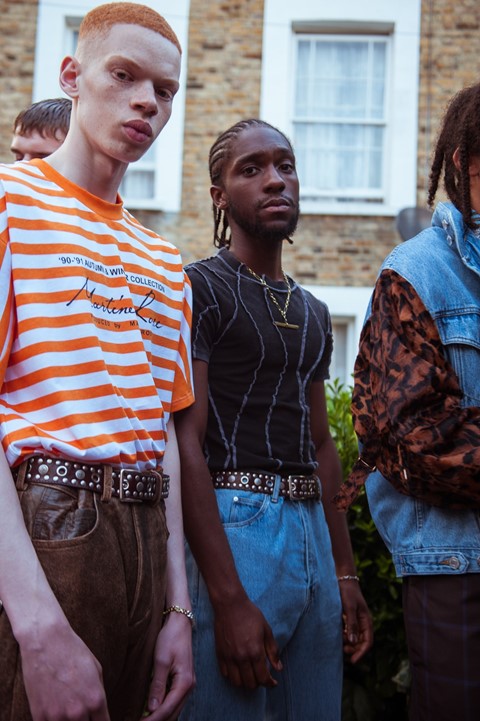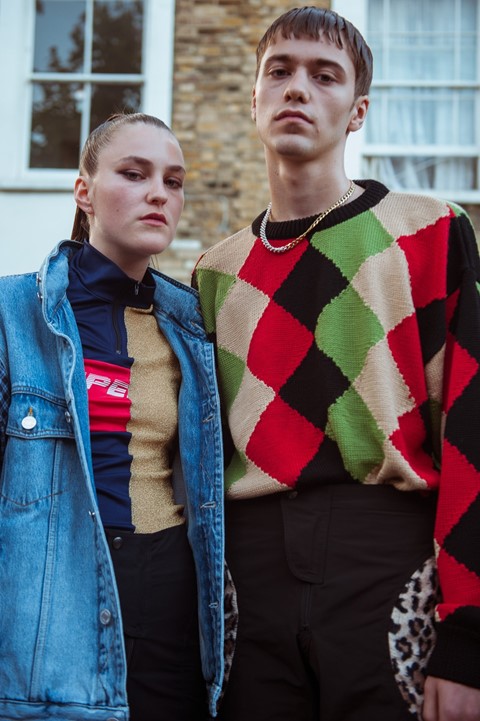In the first instalment of her new monthly column ‘SEXNESS’, Lucy Kumara Moore talks to Martine Rose about the roles sex and desire plays in her work
SEXNESS is a new monthly column exploring the shape of 21st-century desire from Lucy Kumara Moore, director of Claire de Rouen bookshop. A drive from the deep, a contested ground, a spur to our true identity, desire is manifold. Without aiming to be comprehensive, SEXNESS interweaves conversations with friends and personal perspective, to generate a PLEASURE-POSITIVE transmission from the cultural now.
The centrepiece of this inaugural SEXNESS is a conversation I had with London-based menswear designer Martine Rose the other day. I went to visit her in her north London studio with this column in mind, because I knew that we could talk in a spirit of openness and pleasure, setting the tone in the right way for subsequent columns. Martine has always been clear that what she finds hot in a man – her fictional male muse – informs every collection. Her Spring/Summer 2019 collection was described by her press team as a “love letter to London” but it was also a love letter to lust. The Martine Rose man is the Martine Rose muse: she finds him sexy. And that approach is carried through to her consulting work and brand collaborations. Talking about a moment in a fitting for a consulting job, she says:
“I remember we were considering a look and I said, ‘But do we want to have sex with that person?’ and it caused shockwaves! There was a certain formality and hierarchy to the situation I was in, and I don’t think my directness was something they expected. But it was really powerful, it shifted the tone. Every subsequent fitting, this was the subtext. It was out, it was open, it’s what we came back to a lot.”
There is something about the way Martine works, building up wardrobes in each collection that narrate an idea of a fictional man, that I feel is important. Her clothes are an invitation to their future wearers to connect with – embody even – the character that they convey. When she asked, “But do we want to have sex with that person?”, she was talking about the desirability of a certain character, not the model himself. It’s a meaningful distinction, because it’s so often at the level of story, or fantasy, that our desire is formed. On the other hand, our own experiences play their part too.

Lucy Kumara Moore: When I first met you to talk about the Spring/Summer 2019 collection I think part of the reason we connected was that we share an idea of sexiness that comes from fancying boys we used to see, just ‘around’, in London when we were growing up; maybe playing football down the road or hanging out with our brother or cousin. Our idea of hotness connects back to our autobiographies, our experiences, where we grew up, not necessarily a set of physical attributes. Maybe that comes later.
Martine Rose: What I do is tell a story about masculinity. All different versions – including awkward and weird. It’s not how men look that makes them sexy. I can fall in love with anyone really, if they’re interesting, they’ve got good chat, they’re funny, the physical thing is important but there are so many more elements.
Lucy Kumara Moore: The concept of having a type has always been really weird to me.
Martine Rose: So weird. My exes are absolutely nothing alike. I think it’s worth saying that I find men’s fashion at the moment pretty sexless. I find it very safe. I don’t find that real subtext of sex or risk. Part of that is because the translation of streetwear to the catwalk has meant it’s lost some sexiness – it’s been sanitised, paired down, made more digestible and lost its context and codes and street attitude basically. It’s not streetwear that’s not sexy it’s the version of it that we see now. There’s no subtlety about it, it’s like ‘this is a sexy man because he’s into streetwear.’ There’s not much storytelling or fantasy about it. I love streetwear obviously though.
Martine works a lot with streetwear references, but they’re mixed up with looks from the more subversive and often sexed up style codes of music subcultures, normcore/dad design, an attentiveness to tailoring and unusual silhouettes. Adornment is part of her signature, too: Martine understands that a gold earring, something ruched or an embellished jacket can make a man hot.
Martine Rose: I always like when things are just on the edge. A man who’s just on the edge of being dangerous or difficult. I really like that tension. Also, when I design, I really like that tension. Where it could really trip over into terrible very easily.
Lucy Kumara Moore: That feels like a very London thing, that on the edge thing.
Martine Rose: We don’t have such strict codes in London. They’ve been really broken down. One of my heroes is Vivienne Westwood. If you think how overt it was, her sexuality. That she had a shop called Sex. And that it was all based on old bondage gear. It’s incredible. Punk was really sexy. If you think about Jordan, those pictures where she’s flashing her tits or got her bum out, there was no question that those women were being objectified or reduced, or the men, it felt like it was a very equal footing.
Lucy Kumara Moore: It was a moment of radical change with sex at its centre.
Martine Rose: Exactly! So different to now...
Lucy Kumara Moore: Do you like that designer Ludovic de Saint Sernin?
Martine Rose: I do!
Lucy Kumara Moore: Maybe he can be the subject of a future SEXNESS... Anyway, thank you Martine!
Martine Rose: Thank you!
Thank you for reading SEXNESS!
